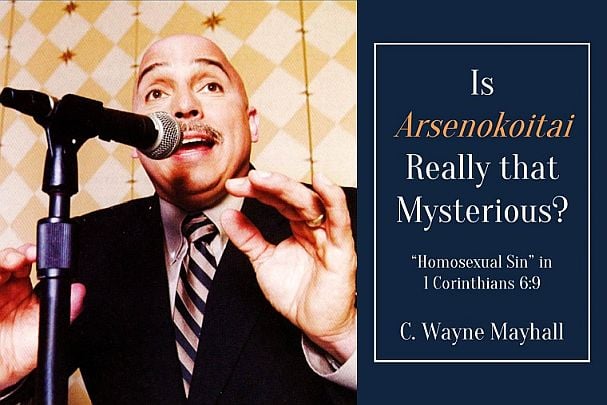This article first appeared in the Practical Hermeneutics column of the Christian Research Journal, volume30, number06 (2007). For further information or to subscribe to the Christian Research Journal go to: http://www.equip.org
“Do you not know that the unrighteous will not inherit the kingdom of God? Do not be deceived. Neither fornicators, nor idolaters, nor adulterers, nor homosexuals, nor sodomites…will inherit the kingdom of God” (1Cor.6:9 NKJV).
Not long ago I was designing an ethics course for a small Christian college when I had the opportunity to interview Reverend Robyn Provis of All God’s Children Metropolitan Community Church in Minneapolis, Minnesota, on the topic of homosexuality and the Bible. Reverend Provis adamantly remarked on several occasions in the interview that a sure-fire way to halt interfaith dialogue in its tracks-one of the most underhanded tactics evangelicals use to justify their position-is the use of what she called the “clobbering” verses of Scripture.
Theologians Douglas Stuart and Gordon D. Fee suggest that “the recognition of a degree of cultural relativity is a valid hermeneutical procedure and is an inevitable corollary of the occasional nature of epistles.”1They offer guidelines2for distinguishing between ideas that are relative to any given culture and ideas that are transcendent of culture and normative for Christians (and non-Christians). One of those guidelines as stated consists of documenting ideas-or the particular use of a word or phrase-about which the New Testament (NT) has a consistent witness and those about which it does not. The following is an application of this guideline to one crucial Greek word, arsenokoitai, which appears in one of the most popular so-called clobbering passages, 1Corinthians6:9-10.
Dirty Old Men? Theologian Mel White3 agrees that the Greek word arsenokoitai, used for “homosexual” in 1Corinthians6:9, seems to refer to same-sex behavior. He argues that Greek scholars don’t know exactly what it means, however, and that this simple detail is a big part of this tragic debate.4
He explains, “Some scholars believe Paul was coining a name to refer to customers of ‘the effeminate call boys.’ We might call them ‘dirty old men.’ Others translate the word as ‘sodomites,’ but never explain what that means.”5
According to White, in 1958, a translator for the New Amplified Bible set historical precedent by translating this “mysterious” Greek word into English as the word “homosexuals,” even though no such word exists in either Greek or Hebrew. It was that translator, according to White, who “placed the word homosexual in the English-language Bible for the very first time.”6
White blames this bad translation for the inability of many NT scholars today to make the proper, culturally relevant application of this passage in 1Corinthians. He adds, “In the past, people used Paul’s writings to oppress women and limit their role in the home, in church, and in society. Now we have to ask ourselves, ‘Is it happening again? Is a word in Greek that has no clear definition being used to reflect society’s prejudice and condemn God’s gay children?'”7
So what is the proper contextual meaning of this mysterious Greek word? The convincing argument from history that Paul is putting forth, White says, is a condemnation of the “married men who hired hairless young boys (malakois) for sexual pleasure just as they hired smooth-skinned young girls for that purpose.”8
In light of this interpretation of the meaning of arsenokoitai, White concludes with an emotional appeal: “Responsible homosexuals would join Paul in condemning anyone who uses children for sex, just as we would join anyone else in condemning the threatened gang rape in Sodom or the behavior of the sex-crazed priests and priestesses in Rome. So…this passage says…nothing about homosexuality as we understand it today.”9
Not Such a Mystery. Clinical psychologist and theologian Stanton L. Jones10 admits that White effectively invokes “the mystery of arsenokoitai,” the unusual word Paul uses in 1Corinthians6:9 and 1Timothy 1:10 that is commonly translated “homosexual sin.”11This, however, is not such a mystery, he argues, and its unraveling reveals a more complex picture of Paul’s use of Leviticus.
Leviticus18:22and 20:13 forbid a man lying with another man as one would with a woman. Leviticus was originally written in Hebrew, but Paul was a Greek-educated Jew writing to Gentiles in Greek, the common language of the day, and probably was using the Greek translation of the Old Testament available in that day, the Septuagint, or LXX, for his Scripture quotations.
The Greek translation of these Leviticus passages condemns a man (arseno) lying with (koitai) another man (arseno); these words (excuse the pun) lie side-by-side in these passages in Leviticus. Paul joins these two words together into a neologism, a new word (as we do in saying database or software), and thus he condemns in 1Corinthians and 1Timothy what was condemned in Leviticus.
Jones believes, then, that the most credible translation of what Paul is condemning in 1Corinthians6:9 is a person doing exactly what Leviticus condemns: engaging in homosexual sex (a man being a “man-lier”). Far from dismissing the relevance of Leviticus, Paul is implicitly invoking its enduring validity for our understanding of sexual sin, and drawing on it as the foundation of his teaching on homosexual conduct. He is saying, “Remember what it said not to do in Leviticus18:22and 20:13? Don’t do that!”
Sparse and Ambiguous Evidence? Theologian John H. Elliott, Professor Emeritus of Theology and Religious Studies at the University of San Francisco, has written one of the most thorough studies of 1Corinthians6:9-10 to date.12 He concludes that “nothing in 1Corinthians, or for that matter in any other biblical writing, speaks directly of the biological or psychological condition of homosexuality or homosexual ‘orientation’ as this is understood today and as it concerns believing Christian gay persons intent on worshipping and serving God.”13
He concludes from his research that the Bible in its entirety, as with 1Corinthians specifically, offers sparse and ambiguous evidence concerning male-male sexual relationships, and is “conditioned by cultural perceptions and behavioral patterns too alien to those of modern times to provide an adequate basis for a contemporary ethic of homosexuality as homosexuality is currently understood.”14 If a case is to be made for or against the morality of homosexuality as it is understood in contemporary society, Elliott argues, it will have to be made on evidence other than 1Corinthians6:9-10 and other similar passages contained in the Bible.
A Dubious Hope. Elliott’s argument does offer additional backing to White’s argument. However, we need search no further than theologian Robert A.J. Gagnon’s excellent rebuttal to the type of argument put forth by Elliott.15 Space constraints will not permit the development of the details of any one particular proposition he puts forth, but a summary of the most prevalent points makes a case strong enough to call in to question Elliott’s support of White’s argument and, in turn, White’s argument itself.
Proposition 1. To broaden the word arsenokoitai to include exploitive heterosexual intercourse appears unlikely in view of the unqualified nature of the Levitical prohibitions.16
Proposition 2. In every instance in which the arsenokoit word group occurs in a context that offers clues as to its meaning (i.e., beyond mere inclusion in a vice list), it denotes homosexual intercourse.17
Proposition 3. The term arsenokoitai itself indicates an inclusive sense: all men who play the active role in homosexual intercourse. Had Paul intended to single out pederasts he could have used the technical term paiderastïs.18
Proposition 4. The meaning that Paul gave to arsenokoitai has to be unpacked in light of Romans1:24-27. When Paul speaks of the sexual intercourse of “males with males” (arsenes en arsenes) in v.27, he obviously has in mind arsenokoitai.19
Based on these propositions and others he explores, Gagnon boldly states that “others would have us believe that it is an open question whether arsenokoitai in Paul’s mind would have applied to all forms of same-sex intercourse, including the kinds of non-exploitative forms allegedly manifested in our contemporary context,” but “this dubious hope has to be maintained in the face of many additional obstacles.”20 Gagnon concludes that 1Corinthians6:9 confirms that Paul’s rejection of homosexual conduct is just as applicable for believers as for unbelievers and that it is self-evident, then, that the combination of terms, malakoi and arsenokoitai, are correctly understood in our contemporary context when they are applied to every conceivable type of same-sex intercourse.
Having more closely documented the particular use of the word arsenokoitai and its consistent witness in the NT, we have discovered that homosexual sin in 1Corinthians6:9-10 isn’t as culturally relevant as many who support the pro-homosexual agenda to normalize aberrant sexual behavior would have us believe.
– C. Wayne Mayhall
_____________________________________________________________________________________________
NOTES
1. Gordon D. Fee and Douglas Stewart, How to Read the Bible for All Its Worth (Grand Rapids: Zondervan, 2003), 71.
2. Ibid., 71-76.
3. Mel White is also a Christian minister and filmmaker, who describes how he reconciles his homosexuality with his Christian faith in his book Stranger at the Gate: To Be Gay and Christian in America (New York: Plume Books, 1994).
4. See White’s “What the Bible Says-and Doesn’t Say-about Homosexuality,” available at http://www.soul-force.org/pdf/whatthebiblesays.pdf. This twenty-four page booklet is widely circulated by Soulforce, an interfaith movement founded by White, that is “committed to ending spiritual violence perpetuated by religious policies and teachings against gay, lesbian, bisexual, and transgender people.”
5. Ibid., 18.
6. Ibid.
7. Ibid.
8. Ibid.
9. Ibid.
10. Jones is Provost of Wheaton College. His scholarly work includes coauthoring with Mark A. Yarhouse, Homosexuality: The Use of Scientific Research in the Church’s Moral Debate (Downers Grove, IL: InterVarsity Press, 2000).
11. Stanton L. Jones, “A Study Guide and Response to: Mel White’s “What the Bible Says-and Doesn’t Say-about Homosexuality,” available at http://www.wheaton.edu/CACE/resources/boolets/StanJonesResponsetoMelWhite.pdf. This forty-one-page booklet is circulated by the Center for Applied Christian Ethics of Wheaton College, in Wheaton, Illinois.
12. This argument appears in Elliott’s “No Kingdom of God for Softies? Or, What Was Paul Really Saying? 1 Corinthians 6:9-10 in Context,” Biblical Theology Bulletin, 34 (Spring 2004): 17-40.
13. Ibid., 38.
14. Ibid., 39.
15. This argument appears in Robert A. J. Gagnon’s The Bible and Homosexual Practice: Texts and Hermeneutics (Nashville: Abingdon Press, 2001), 303-39. Gagnon, Associate Professor of New Testament at Pittsburgh Theological Seminary, is also the author of the following related works: Homosexuality and the Bible: Two Views (Minneapolis: Fortress Press 2003), and Does the Bible Regard Same-Sex Intercourse as Intrinsically Sinful?” in Christian Sexuality, ed. R. Saltzman (Minneapolis: Kirk House, 2003).
16. Ibid., 319.
17. Ibid.
18. Ibid. 325
19. Ibid., 326.
20. Ibid., 325









